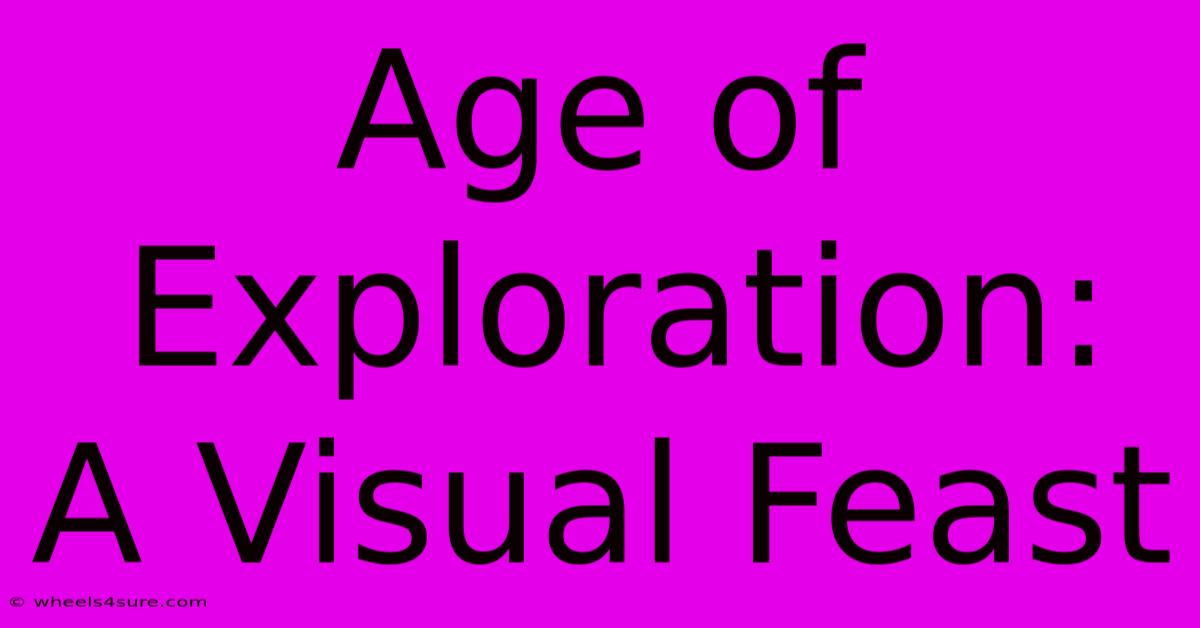Age Of Exploration: A Visual Feast

Table of Contents
Age of Exploration: A Visual Feast
The Age of Exploration, a period spanning roughly from the 15th to the 17th centuries, wasn't just about daring voyages and geographical discoveries; it was a breathtaking spectacle of human ambition, cultural exchange, and artistic expression. This era left behind a rich tapestry of visual records, offering us a captivating glimpse into a world brimming with wonder and hardship. Let's embark on a visual journey through this fascinating period.
Maps: Charting the Unknown
One of the most striking visual legacies of the Age of Exploration is the map. Early maps, often hand-drawn and meticulously detailed, weren't just tools for navigation; they were works of art. Portolan charts, with their intricate compass rose and detailed coastlines, showcase the growing understanding of the world's geography. These weren't mere depictions of land; they represented ambition, the drive to uncover what lay beyond the horizon. Notice the artistic flourishes, the mythical creatures sometimes included, reflecting the imaginative spirit of the era alongside its thirst for knowledge. The evolution of cartography during this period is a story in itself, showcasing the gradual refinement of techniques and the expansion of geographical knowledge.
Key Map Features to Look For:
- Compass Roses: These iconic symbols guided navigators and added a distinct aesthetic to early maps.
- Detailed Coastlines: The meticulous depiction of shorelines reflects the importance of coastal navigation.
- Mythical Creatures and Decorative Elements: These elements speak to the blending of fact and fantasy in early cartography.
- Artistic Styles: Pay attention to the unique styles of individual cartographers and the evolution of mapmaking techniques.
Paintings and Illustrations: Capturing Encounters
Paintings and illustrations from the Age of Exploration provide invaluable insights into the encounters between different cultures. Think of the vibrant depictions of exotic flora and fauna, the portraits of indigenous peoples, and the scenes of bustling ports showcasing the exchange of goods and ideas. These images, though often filtered through the lens of European perspectives, offer glimpses into a diverse world, reflecting the cultural impact of these voyages.
Key Visual Elements to Analyze:
- Depictions of Indigenous Peoples: How are different cultures represented? What biases might be present?
- Exotic Flora and Fauna: Note the detail and artistry in depicting new species discovered during voyages.
- Port Scenes: Observe the activities taking place in bustling ports and the interaction between different groups of people.
- Ships and Maritime Scenes: Analyze the depictions of ships and sailing techniques.
Artifacts and Objects: Tangible Remnants of Exploration
Beyond paintings and maps, countless artifacts offer a tangible connection to the Age of Exploration. From precious spices and silks traded along newly established routes to navigational instruments like astrolabes and compasses, these objects speak volumes about the economic and technological advancements of the time. Museums worldwide hold vast collections offering a three-dimensional perspective on the era. These tangible remnants allow us to understand the material culture and trade networks that flourished.
Explore these artifact categories:
- Trade Goods: Examine the variety and origin of goods exchanged during the Age of Exploration.
- Navigational Instruments: Learn about the technology that made long voyages possible.
- Personal Artifacts: Discover the personal items carried by explorers and traders.
Conclusion: A Legacy in Images
The Age of Exploration is not just a chapter in history; it is a visual spectacle. By exploring the maps, paintings, illustrations, and artifacts of this era, we can gain a much deeper understanding of its profound impact on the world. This visual feast allows us to appreciate not only the geographical discoveries but also the cultural exchange, artistic achievements, and the human drama that unfolded during this transformative period. Take the time to delve into these visual records; they are a treasure trove of information waiting to be discovered. The visual legacy of the Age of Exploration is a testament to human curiosity, ingenuity, and the enduring power of exploration.

Thank you for visiting our website wich cover about Age Of Exploration: A Visual Feast. We hope the information provided has been useful to you. Feel free to contact us if you have any questions or need further assistance. See you next time and dont miss to bookmark.
Featured Posts
-
Nkosazana Daughter The Songs That Changed Her Life
Apr 05, 2025
-
The Unseen Side Of Son Suk Ku
Apr 05, 2025
-
Discover The Kaka Son Advantage
Apr 05, 2025
-
Grand Bazaar Suicide A Deeper Look
Apr 05, 2025
-
Justin Trudeaus Daughter A Celebration Of Youth
Apr 05, 2025
